Posted by Wendel Swan on 06-02-2003 01:09 PM:
A Seistan of another color?
Dear Tom and all,
Many years ago I bought this Belouch group bag face
primarily because of its overall light color palette. As with many others, this
one shows better in good light. In the flesh, it seems lighter than the image
suggests.
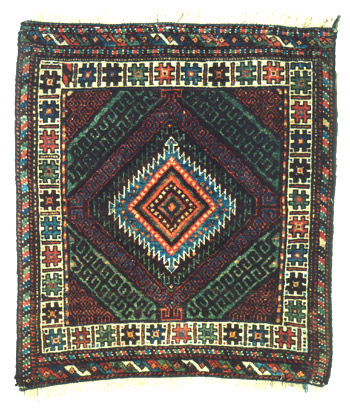
For the purposes of being consistent with Tom’s details, here
is a close up of the center of the medallion. The red tones are a bit redder
than they appear on the monitor:
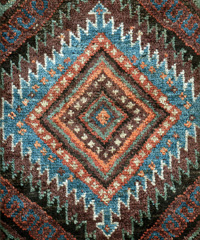
And as far as
structure is concerned, here is a detail of the back:
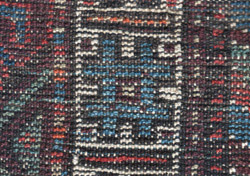
This face is also
distinguished by the number of colors used and the juxtaposition of those
colors. There are nine distinct colors: red, orange, yellow, light blue, medium
blue, green, aubergine, black and ivory. Two shades of red and two of yellow are
used, but the variations do not appear to be intentional, so I didn’t count them
as separate colors.
The bag is finely woven: 10 knots to the inch
vertically and 10.5 horizontally, for 105 kpsi. Knots are asymmetrical, open to
the left. Warps are light ivory, wefts are primarily dark brown (black) but at
least three other colors are sparingly used. The warps are not depressed at
all.
It seems to be what Tom would call Seistan.
Comments?
Wendel
Posted by Patrick Weiler on 06-03-2003 12:04 AM:
Same design
Wendel,
You probably noticed that the border of your bagface has the
same design as the Seistan band I have shown on another thread. In my band,
though, the center of each of the tic-tac-toe devices has a five-point "dice"
motif. This is probably because the weaver of the band had more room to fill in
the centers - the band is 3 1/2" wide and your border is probably
smaller:
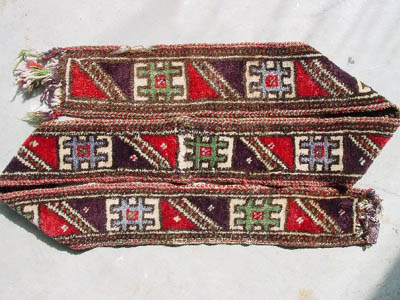
The band has asymmetric, open left knots at about 8x8 = 36 kpsi
and ivory or brown wefts. The warps show moderate depression, different from
your bagface.
Both weavings show similarities in the bright colors, too, but
I assume your bagface is older due to the fading of the blue in my band. A deep
eggplant aubergine seems to be common to both weavings, too. The little crosses
around the center designs of your bagface also show up in many of the triangle
areas of the band.
I have seen this border design in weavings from other
areas, so it is probably not exclusive to Seistan, but it seems to be cropping
up a lot!
Patrick Weiler
Posted by Marvin Amstey on 06-03-2003 09:11 AM:
As long as we are on the subject of light-colored Baluchi's, here is an image
of a relatively old pushti. You'll notice, Patrick, that the same tic-tac-toe
boxes appear randomly in this one also:
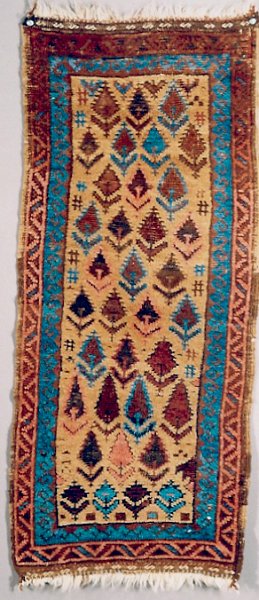
Posted by Richard Tomlinson on 06-03-2003 09:58 AM:
hi
i will just get in here before the discussion develops and
say,
"Marvin - that is the most beautiful beluch pushti or balisht i have
EVER seen"
fantastic !!!
regards
richard tomlinson
Posted by Tom Cole on 06-03-2003 11:38 AM:
Wendel.. Seistan would be the area for where this weaving originates... and
Marvin... GREAT pushti! Wonderful thing.. appears to be old AND
beautiful!
Posted by Henry Sadovsky on 06-03-2003 04:56 PM:
Hi Wendel. Would you say something about the wool, hand, and handle of your
piece? At the time of your aquisition of it, or subsequently, have you learned
anything of interest bearing on its origin and age?
Hi Marvin. I pose you
the same questions as I did Wendel. Additionally, what are the dimensions of
your piece? Was there ever a time when you would have refered to such a piece as
a "balisht" (or some variant spelling of same)? If so, what has caused you to
now call it a pushti?
Posted by Wendel Swan on 06-04-2003 05:26 PM:
Hello Henry,
Although I bought my bag face in Minneapolis more than 20
years ago, I’ve learned little about it since. The collector/dealer from whom I
bought it had a good eye but none of us knew enough then to say anything more
than “Belouch.”
As you can see from the back, the pile yarns are
relatively thin, so it has a loose and pliable handle in spite of being rather
finely woven.
The wool feels quite soft, but isn’t particularly glossy or
lustrous. With some Belouch group pieces, you can practically feel the lanolin
oozing out. Not so with this one. It has always seemed very clean, so I don’t
believe that an ordinary wash would change its feel. The pile was probably never
very high.
Incidentally, the colors look entirely different on my monitor
at work and that at home. Who knows how they appear to other readers?
I’m
not sure this information is of any help, but I can’t say much more. You can see
it the next time you're in Washington.
Wendel
Posted by Marvin Amstey on 06-04-2003 06:15 PM:
Good evening, Henry.
I chose the word "pushti" because it popped into my
mind first, and I like the sound of that word better than "balischt". Otherwise
I don't have a clue as to whether one is or isn't the other. From an aesthetic
point of view, the topic of this salon, it makes no difference. More genreally,
it never made any difference to me - same with the tribal attributions (that's
another word I like) since speculation is not my game. The "pushti" is coarsely
woven at about 56 kpsi. The wool is lustrous and soft, and the handle is very
floppy. The field is camel hair as it is in full pile with the brown trees
corroded. The light blue is also in full pile. Unfortunately, someone tried to
fill in some of the brown corrosion and I haven't taken the time to remove it.
The size is 1'4" x 3'1/2", excluding the kilim ends. Hope this answers your
questions.
Best regards
Posted by Henry Sadovsky on 06-05-2003 01:37 AM:
Nomenclature
Hi Wendel. Hi Marvin. Thank you both for the info.
Wendel- it seems
that your bagface is not a part of a pannier pair that would have been connected
by pile shoulders. Thus, it is either one of a pair of "khorjin" that are
connected with a typical flatweave bridge, or it was a single bag. If its
shorter dimension is more that 28", I think that would favor the latter
possibility.
Marvin- I have seen a couple of bagfaces which are the same
"type" (including identical dimensions) as yours. Many 16" wide bags are about
32" long, while yours (and others) are 42".
I would think that we can't
call all three types of single bags "poshti" as, at the least, it would readily
lead to confusion. As there seems to be disagreement over what the people in the
area of where these things are found call them, perhaps we should make no
assumptions and simply call:
A square (single) bag- A square
bag.
One of a pair of "khorjin"- A pannier bag (leaves more to the
imagination than "donkey bag").
A bag previously known as "balisht"- A
long bag.
An especially long "balisht- An extra-long bag.
This
has nothing to do with aesthetics and everything to do with: communication,
classification, clarity, and appropriate humility for what we do and do not
know.
I feel a little silly for writing the above. However, if a field
is to advance, clarity and consistency are essential. Anything short of that
invites confusion, miscommunication, and the ignoring of what we think we have
learned by the following generation.
Just some thoughts...
Posted by Steve Price on 06-05-2003 06:20 AM:
Hi Henry
I applaud your effort to give things names that make sense
instead of trying to use words in languages we don't understand or guessing at
their uses.
I tried something similar with Turkmen spindle and spoon
bags in an article in HALI some years ago, proposing that we just call them
portrait format bags instead of pretending that we could tell by looking at them
what they contained when they were in situ. No takers. For years, Peter
Andrews tried to get the rug world to use the correct Turkmen word for what we
insist on calling ok-bash. Despite my attempts to help (perhaps because of them
 ), it never got very far
either.
), it never got very far
either.
I hope your idea catches on. Maybe best that I don't try too hard
to help out, though.
Regards,
Steve Price
Posted by Wendel_Swan on 06-05-2003 08:10 AM:
Hi Henry,
As it exists now, my bag face is 23.5 inches wide and 26
inches high. Although the selvedges are not original, it doesn't seem that there
would have been any significant additional width.
I had never before
contemplated whether it might have been pannier format.
The face, as you
see it in my post, is the way it would have been on the loom, with the pile
pointing downward.
Does a weaver begin a chanteh (single bag) by weaving
the back first or the pile first? If pile is first, that would make the pile go
upwards when sewn together and used.
Wendel
Posted by Henry Sadovsky on 06-05-2003 12:04 PM:
Proposal: "Chanteh" = Small bag
Hi Wendel. I think your bagface is too large to have been part of what is
often times called a 'Baluch' "chanteh". Usually these are in the neighborhood
of 14", more or less squarish.
It is likely that 'Baluch' pile weavings
are the products of peoples of more than one language. It, therefor, is rather
doubtful that they all used words such as: "chanteh", "balisht", "poshti", and
"khorjin". Perhaps we should be calling 'baluch' "chantehs"- small
bags?
With regards to your question, I am not sure I recall seeing a
'Baluch' "chanteh" that was not pile on both sides- one side with the pile
pointing down and the other side with the pile pointing up.
Henry
Posted by Tom Cole on 06-05-2003 01:20 PM:
The bag shown by Wendel is probably one half of a complete khorjin and cut.
Note the continuation of the minor border (with white composed of diagonal
oriented 'design') extends to the bottom edge without turning the corner and
continuing along the bottom edge. I may be mistaken, without seeing the piece in
person or a detail of the bottom edge to see if any flatwoven end finish is
extant along these minor borders, it is difficult to speculate.. but I would
guess it is, as I say, cut. Many are.
By the way, the word 'chanteh'
exists in many languages, and in Farsi, it refers to bags that serve a special
function. They are repositories for personal possessions, often made as dowry
pieces, often made in pairs, double sided bags that are folded in half and
closed along the sides. The same goes for 'balisht', made for a specific purpose
(pillow on which to rest one's head), again often made in pairs and associated
with dowry weaving (refer HALI 76, From the Horses Mouth, for the reference to
dowry).
Posted by Marvin Amstey on 06-05-2003 03:21 PM:
I'm not so sure that my "long-bag" (36 and one-half inches) is a bag. What
remains of the end finishes are identical top and bottom. There is no evidence
that this had a back. Did the Baluchi - or whoever - weave pillow covers like
Anatolian yastiks?
Posted by Steve Price on 06-05-2003 03:55 PM:
Hi Marvin
I don't know whether the Belouch wove pillows in the 19th
century, but they've sure made a lot of them since World War
II.
Regards,
Steve Price
Posted by Tom Cole on 06-05-2003 06:17 PM:
Marvin.. Balisht are the 'Baluch' version of yastiks.. .same function.





 ), it never got very far
either.
), it never got very far
either.